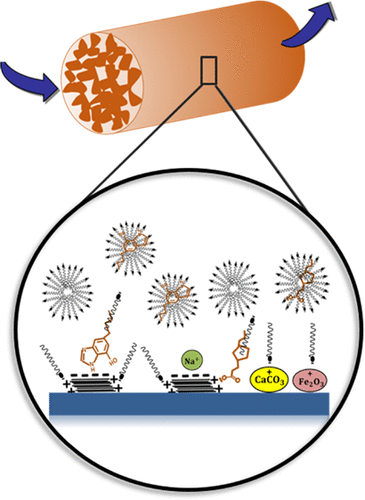Our official English website, www.x-mol.net, welcomes your feedback! (Note: you will need to create a separate account there.)
Role of Wettability on the Adsorption of an Anionic Surfactant on Sandstone Cores.
Langmuir ( IF 3.9 ) Pub Date : 2020-09-01 , DOI: 10.1021/acs.langmuir.0c01521 Mohammadreza Amirmoshiri 1 , Leilei Zhang 1 , Maura C Puerto 1 , Raj D Tewari 2 , Ridhwan Zhafri B Kamarul Bahrim 2 , Rouhi Farajzadeh 3 , George J Hirasaki 1 , Sibani Lisa Biswal 1
Langmuir ( IF 3.9 ) Pub Date : 2020-09-01 , DOI: 10.1021/acs.langmuir.0c01521 Mohammadreza Amirmoshiri 1 , Leilei Zhang 1 , Maura C Puerto 1 , Raj D Tewari 2 , Ridhwan Zhafri B Kamarul Bahrim 2 , Rouhi Farajzadeh 3 , George J Hirasaki 1 , Sibani Lisa Biswal 1
Affiliation

|
We investigate the dynamic adsorption of anionic surfactant C14 – 16 alpha olefin sulfonate on Berea sandstone cores with different surface wettability and redox states under high temperature that represents reservoir conditions. Surfactant adsorption levels are determined by analyzing the effluent history data with a dynamic adsorption model assuming Langmuir isotherm. A variety of analyses, including surface chemistry, ionic composition, and chromatography, is performed. It is found that the surfactant breakthrough in the neutral-wet core is delayed more compared to that in the water-wet core because the deposited crude oil components on the rock surface increase the surfactant adsorption via hydrophobic interactions. As the surfactant adsorption is satisfied, the crude oil components are solubilized by surfactant micelles and some of the adsorbed surfactants are released from the rock surface. The released surfactant dissolves in the flowing surfactant solution, thereby resulting in an overshoot of the produced surfactant concentration with respect to the injection value. Furthermore, under water-wet conditions, changing the surface redox potential from an oxidized to a reduced state decreases the surfactant adsorption level by 40%. We find that the decrease in surfactant adsorption is caused not only by removing the iron oxide but also by changing the calcium concentration after the core restoration process (calcite dissolution and ion exchange as a result of using EDTA). Findings from this study suggest that laboratory surfactant adsorption tests need to be conducted by considering the wettability and redox state of the rock surface while recognizing how core restoration methods could significantly alter the ionic composition during surfactant flooding.
中文翻译:

润湿性对阴离子表面活性剂在砂岩岩心上的吸附作用。
我们研究了阴离子表面活性剂C 14-16的动态吸附在代表储层条件的高温下,具有不同表面润湿性和氧化还原状态的Berea砂岩岩心上的α烯烃磺酸盐。表面活性剂的吸附水平是通过使用兰格缪尔等温线的动态吸附模型分析废水历史数据来确定的。进行了各种分析,包括表面化学,离子组成和色谱分析。已发现,与水湿芯相比,中性湿芯中表面活性剂的穿透延迟要更长,这是因为沉积在岩石表面的原油成分通过疏水相互作用增加了表面活性剂的吸附。随着表面活性剂的吸附得到满足,原油成分被表面活性剂胶束溶解,一些吸附的表面活性剂从岩石表面释放出来。释放的表面活性剂溶解在流动的表面活性剂溶液中,从而导致所产生的表面活性剂浓度相对于进样值超调。此外,在水湿条件下,将表面氧化还原电势从氧化状态改变为还原状态会使表面活性剂的吸附量降低40%。我们发现,表面活性剂吸附的降低不仅是由于去除了氧化铁,而且还因为在岩心修复过程之后(通过使用EDTA造成的方解石溶解和离子交换)改变了钙浓度。
更新日期:2020-09-15
中文翻译:

润湿性对阴离子表面活性剂在砂岩岩心上的吸附作用。
我们研究了阴离子表面活性剂C 14-16的动态吸附在代表储层条件的高温下,具有不同表面润湿性和氧化还原状态的Berea砂岩岩心上的α烯烃磺酸盐。表面活性剂的吸附水平是通过使用兰格缪尔等温线的动态吸附模型分析废水历史数据来确定的。进行了各种分析,包括表面化学,离子组成和色谱分析。已发现,与水湿芯相比,中性湿芯中表面活性剂的穿透延迟要更长,这是因为沉积在岩石表面的原油成分通过疏水相互作用增加了表面活性剂的吸附。随着表面活性剂的吸附得到满足,原油成分被表面活性剂胶束溶解,一些吸附的表面活性剂从岩石表面释放出来。释放的表面活性剂溶解在流动的表面活性剂溶液中,从而导致所产生的表面活性剂浓度相对于进样值超调。此外,在水湿条件下,将表面氧化还原电势从氧化状态改变为还原状态会使表面活性剂的吸附量降低40%。我们发现,表面活性剂吸附的降低不仅是由于去除了氧化铁,而且还因为在岩心修复过程之后(通过使用EDTA造成的方解石溶解和离子交换)改变了钙浓度。


























 京公网安备 11010802027423号
京公网安备 11010802027423号